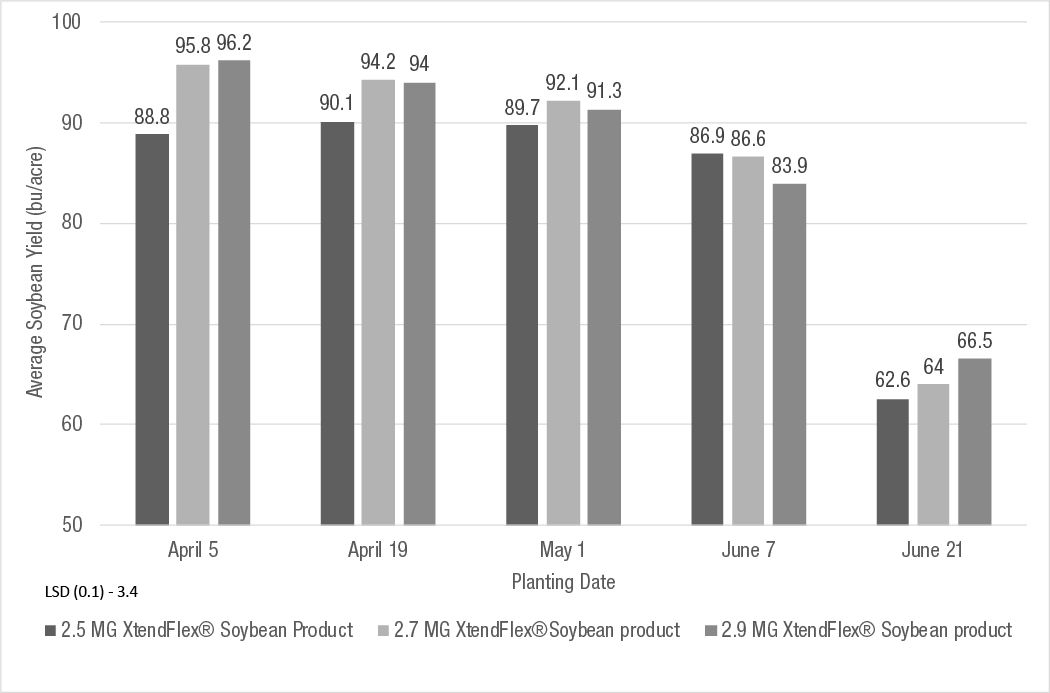5 MIN READ
The Effect of Seeding Rate and Planting Date on Irrigated XtendFlex® Soybeans
December 8, 2021
The Effect of Seeding Rate and Planting Date on Irrigated XtendFlex® Soybeans - 2021
TRIAL OBJECTIVE
XtendFlex® Soybeans are a new technology that was recently released for producers. Given that this technology has only undergone one growing season as a commercial product, various questions have arisen about product vigor under different agronomic practices and weather conditions.
The objective of this study was to determine the effect of planting date and seeding rate on three XtendFlex® Soybean products.
RESEARCH SITE DETAILS
| Location | Gothenburg, NE |
| Soil Type | Hord silt loam |
| Previous Crop | Corn |
| Tillage Type | Strip-Tillage |
| Planting Date | See below |
| Harvest Date | See below |
| Potential Yield (bu/acre) | 80 |
| Seeding Rate (seeds/acre) | See below |
- The trial was arranged as a randomized split-split plot design with planting date as the whole plot, seeding rate as a sub plot, and soybean product as the sub-sub plot.
- Planting Dates
- 4/5/2021, 4/19/2021, 5/1/2021, 6/7/2021, and 6/21/21
- Seeding Rates
- 40,000, 80,000, 120,000, 160,000, 200,000, and 240,000
- Soybean Products
- 2.5 Maturity Group (MG) XtendFlex® Soybean product
- 2.7 MG XtendFlex® Soybean product
- 2.9 MG XtendFlex® Soybean product
- Soybeans were irrigated throughout the growing season.
- 60 lb phosphorus (P)/acre, 25 lb sulfur (S)/acre, 0.25 lb zinc (Zn)/acre were applied through strip-tillage application prior to planting.
- Weeds were controlled uniformly across the study.
- Harvest Dates
- 9/27/2021, 9/28/2021, 9/29/2021, 10/10/2021, and 10/16/2021
UNDERSTANDING THE RESULTS
Planting date (results averaged by soybean product over all seeding rates)
The highest soybean yields were consistently observed with early planting dates (especially in April and May) (Figure 1).
The longer maturity group (MG) products (2.7 and 2.9 MG) had higher yields on April 5 and April 19 planting dates compared to the shorter MG soybean product (2.5 MG) (Figure 1).
There was no difference in yield between the 2.7 and 2.9 MG products regardless of planting date (Figure 1).
The June 21 planting date had a negative impact on yield on all soybean products (Figure 1).

Seeding rate (results averaged over planting dates)
Soybean seeded at 40,000 seeds/acre had the lowest yields across all soybean products (Figure 2).
The 2.5 MG soybean product had similar yields within the range of 80,000 to 240,000 seeds/acre (Figure 2).
The 2.7 MG soybean product average yield increased steadily within the 80,000 to 200,000 seeds/acre range and then declined significantly at the higher seeding rate of 240,000 seeds/acre (Figure 2).
No difference in yield was observed from 80,000 to 200,000 seeds/acre for the 2.9 MG soybean product. The highest average yield was obtained with the 240,000 seeds/acre rate (Figure 2).

KEY LEARNINGS
For this study, plots planted at the earlier planting dates had higher yields across all soybean products, especially in the 2.7 and 2.9 MG. Late planting (June 21) had a negative impact on yield regardless soybean maturity group.
Depending on soybean product, irrigated XtendFlex® Soybeans planted in the range of 160,000 to 240,000 seeds/acre helped maximize yield potential.
Farmers should work with their local seeds sales team member to help identify the best adapted XtendFlex® Soybean product for their production systems.
3019_R1